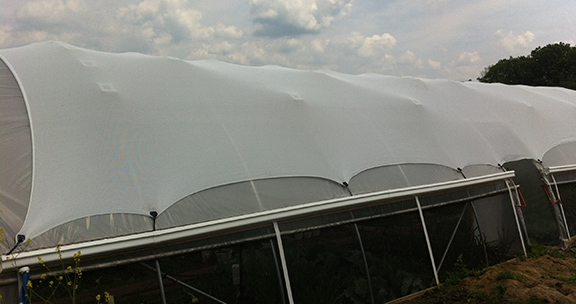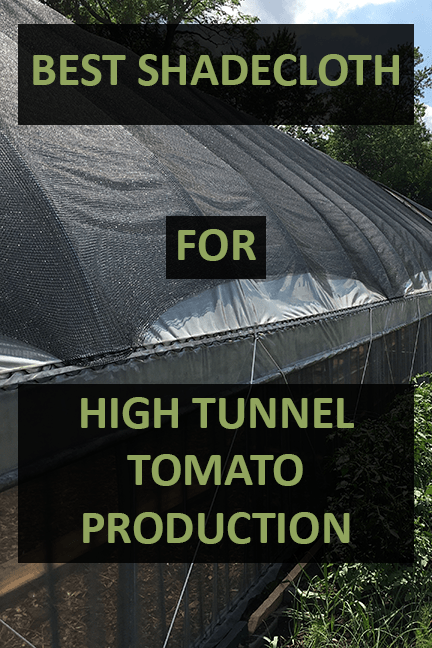Best Shade Cloth for Tomato Production - Reduce Detrimental Scalding and Shouldering - Your Yield is Your Profit

While tomatoes like warm weather, most varieties tend to struggle immensely when temperatures start breaking into the high 80’s and 90’s. These high temperatures can negatively impact tomato production just as much as cold temperatures.
Sun scald, fruit cracking, blossom drop, uneven ripening, and Yellow Shouldering Disorder are just a few of the negative impacts too much heat (and sunlight) can have on production. For this reason, keeping tomatoes cool in the hottest part of the year is vital for improved tomato production. Finding the best shade cloth for tomato plant protection is a big part of maintaining yield.
The Best Shade Cloth for Tomatoes
In this post we outline the best shade cloth for tomato production. Our conclusions are based on conversations with various growers, as well as referencing numerous agricultural extension offices across many states.
While there are many variables for growers in different climates (which we cover further on in this post) here are our conclusions based on available research for the best shade cloth for tomato production:
Best all around shade cloth for tomato production: 40% black shade cloth
Best reflective shade cloth for tomato production: 40% Aluminet Shade Cloth
Best budget shade cloth for tomato production: 30% black shade cloth
While having reflective properties for shade cloth has its benefits, we selected the 40% black shade cloth as the overall best for production because it is a bit more affordable when compared to the reflective options on the market.
If there is room in your budget for reflective shade cloth it is definitely worth considering since there are additional benefits from the aluminet and white shade cloth. We cover these in more detail further on in this post.
Research Supports Between 30% and 50% Shade Cloth Best for Tomato Production
Our focus here is on high tunnel and greenhouse production. That is to say, we manufacture high tunnels and greenhouses. And while we work with farmers very closely, and have experience growing ourselves, we find it best to reference experts and data when trying to determine which growing methods will be best for yield and production.
Below are some quotes from agricultural extension services regarding the use of shade cloth for tomato production.
From West Virginia
"Shade fabric (30-50%) will lower air temperatures within the high tunnel by as much as 5-8 degrees Fahrenheit"
"Yellow shouldering disorder (YSD) of tomatoes is exacerbated by high air temperatures. Shade cloth (30-50%) can reduce YSD."
-Lewis W. Jett, West Virginia University Agricultural Extension; High Tunnel Temperature Management
From Arizona
"The best shade level is 20 to 40% shade...even with our heat the whole plant doesn't need to be shaded."
-Yavapai County Cooperative Extension, Tomato - Planting/Growing/Harvesting
From Indiana
"My suggestion is to apply shade cloth, but only use the ones that have moderate shade level such as 30% shade or less."
"If shadecloth is used till the end of the season, this practice might increase tomato yield in a hot summer, considering there would be less blossom drop because of the lower temperature."
- Wenjing Guan, Purdue State University Extension, Whether to Put Shade Cloth on High Tunnel Tomatoes
The research of agricultural extension offices, regardless of geographic location, has seemed to come to similar findings. More specifically, that shade percentages between 30% and 50% are best. These findings seem to span different regions of the US where seasonal high temperatures and number of days with full sun vary.
RELATED: Pre-Cut Greenhouse Plastics Ready to Ship Now
The various stances from agricultural extensions across the country led us to the recommendations we make at the beginning of this post.
Why 40% vs a 50% or 60% Shade Cloth for Tomato Production
While the agricultural extension papers we reference recommend lower shade cloth percentages for tomato production we do recognize that all climates are different, and we also understand that there are different ways shade cloth can be employed to protect tomatoes.
For example, maybe your plan is to put on and take off shade cloth as temperatures go up and down. Maybe for this application it makes more sense to use a higher percentage shade cloth to curb the highest spikes in temperature on any given day.
For the most part, however, the reasons higher percentage shade cloth isn't recommended by most agricultural extension services for tomato production has to do with potential reductions in tomato yield.
Affects of Greater Shade Percentages / Densities
According to Wenjing Guan at Purdue State University Agricultural Extension, "When shade level is more than 50% plants developed larger but thinner leaves, longer internodes and less vegetative biomass. Water, nitrogen and potassium uptake was declined as shade density increase."
Further on in his report Guan states, "...50% shade was applied at the time when greenhouse tomato began to ripe, total yield was reduced after 3 weeks of shad application even though the early yield was not affected."
It should be noted, however, that the study Guan is referencing above took place in the northeastern United States. Regardless of this fact, the decreased yield and nutrient uptake is enough to question higher shade cloth percentages.
If growers in your area typically use a shade cloth percentage greater than 50% there are likely reasons for it. Or, perhaps, the duration and type of application is such that it doesn't hinder plant growth, nutrient uptake, or yield. If this sounds like what you need to do, here is a link to some high quality knitted 60% shade cloth.
Why White and Aluminet Shade Cloths Are Great Options
White and aluminet shade cloth options are quickly becoming favorites for tomato producers. The reason for this is the additional heat they tend to keep off the structures. Black shade cloth absorbs more heat than white or aluminet shade cloth, and for that reason structures with white or aluminet shade cloth coverings can reach even further reduced temperatures.

The aluminet, and white shade cloths are reflective in nature so they do a good job of reducing the amount of light that gets in while also reflecting the light that doesn't get in away from the tunnel.
Know Your Climate Before Selecting Shade Cloth
This sounds obvious, but it needs to be stated. If you live in Cleveland, OH where there are approximately 299 cloudy days each year it is unlikely you will require the same shade cloth that a grower in Palisade, CO where the number of overcast days are minimal.
Extension services provide great research and guidance, but that doesn't mean you can't manage tomato production with a different shade cloth percentage. As mentioned above, some people put on and take off shade cloth intermittently. While this comes with increased labor inputs it may be worth considering for some growers if time and labor are available.
Day Length Matters More for Some Growers than Others
This might sound the same as checking how overcast your climate is, but it is referring more to actual hours of day.
For example, climates further north and south in relation to the equator may experience vastly longer day lengths for a part of the season than climates close to the equator. This can translate to a ton of sun.
I had a conversation about this with someone in Alaska, just the other day. They are located where it gets very cold, but during parts of the summer they get about 22 hours of daylight. That’s a lot of sun!
In the scenario outlined above, the growers' tomatoes are being grown inside a high tunnel. Since high tunnels are designed to efficiently capture and hold heat the tomatoes get hammered during the longest days of the year. That much sunlight combined with that much heat can present a lot of challenges for mitigating temperatures and maintaining tomato yield.
Begin Using Shade Cloth For Tomato Production
Tomatoes are one of the most profitable crops to grow inside high tunnels and hoop houses. As such, their yield and fruit quality should be a priority for growers.
The reduction in high temperatures will reduce blossom drop, which will increase the number of fruit that reach harvest. Additionally, the reduction in intense sunlight will reduce the incidence of Sunscald and Yellow Shouldering Disorder.
Whether 30%, 40% or 50% shade cloth, if you are growing tomatoes in a high tunnel, implementing some form of shade protection through the hottest months of the year are likely to increase yields significantly.
Since standard shade cloth can be used for about ten years, shade cloth is an investment that has a reasonable "pay-back period" in the sense that increased yields could pay for the cost of the shade cloth over time.
For those growers not yet using shade cloth in their tomato production, it may make sense to begin exploring how you could employ shade cloth to improve yield and profitability.
RELATED:
- Best Greenhouse Plastic - Based on Experience
- 10 Crucial Building Components for High Tunnels
- 9 Most Profitable Winter High Tunnel Crops
- How to Build a Large High Tunnel
- 4 Ways to Attach Greenhouse Plastic to a Large Frame
- High Tunnels vs Greenhouses | Which is Right for Me?


